Recent Storm Damage Posts
Stay Safe When Lightning Strikes
7/10/2023 (Permalink)
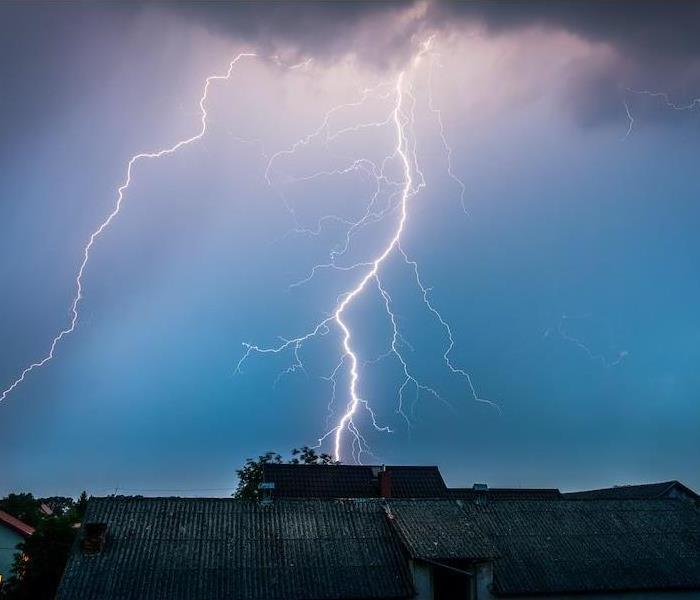 If your home has been damaged by a storm, contact SERVPRO of Gordon, Murray, & South Whitfield Counties 24/7 to get the recovery process started.
If your home has been damaged by a storm, contact SERVPRO of Gordon, Murray, & South Whitfield Counties 24/7 to get the recovery process started.
While lighting striking your home may seem like a rare phenomenon, it’s way more common than you’d think. Each year, one in 200 homes is struck by lightning, and there are around 20 lightning-related fatalities annually in the United States.
Knowing what to do and where to go during storms is the best way to protect yourself from this hazard that is created by severe weather. Lightning can not only be a danger to humans but to homes as well. While the path of lightning is unpredictable, knowing the facts can help you best avoid these unexpected bolts from the blue.
The Facts About Lightning
Lightning is a strong sudden burst of electricity, which can travel at about 220,000,000 mph!
Lighting is usually produced during thunderstorms and is more likely to develop during the spring and summer seasons.
While lightning can touch down near or inside your home and create flames, it doesn’t have to strike your home to damage it. When lighting strikes items near your home such as concrete or your gutters, it can surge your home’s electrical system.
A direct hit can also cause damage to electrical and non-electrical items inside your property or severely damage your home’s foundation, chimney and roof.
Here’s how to protect yourself and your home:
Safeguard your home. The simplest way to protect the inside of your home from lighting is by unplugging all electronics before a storm or as soon as you hear a clap of thunder. Lightning is capable of ruining phones, computers and even that fancy new television you just bought.
There are other effective ways to defend your property, but they may be more costly. Of course, approaches such as installing lightning rods on your roof, grounding your home and investing in surge protectors to protect electronics are still beneficial. These precautions could significantly reduce your risk of exterior property damage from lightning.
Know where to shelter. A safe shelter is essential for avoiding lightning. Seek shelter in an enclosed building or a car with a hard-topped roof. If you happen to be outside during a storm and you are unable to seek shelter indoors, avoid bodies of water and shelter near lower trees.
The best way to know when it’s safe to leave your shelter is by listening for thunder. Wait about 30 minutes after hearing a clap of thunder before returning outside.
Unplug your stuff. As stated above, it’s crucial to unplug any electric devices before a storm touches down in your area. If lightning were to strike a nearby electrical pole, it could lead to an electrical surge and completely fry any plugged-in devices.
Making sure to do this ahead of storms is crucial because unplugging equipment during storms puts you at risk of being electrocuted. Staying weather-aware can help you know when it’s time to unplug any devices and seek appropriate shelter.
If your home is impacted by any weather hazards like lightning, our professionals at SERVPRO can be on the scene fast. We have years of experience restoring storm-damaged homes to their preloss state.
How to Prepare Your Home for Severe Weather
6/23/2022 (Permalink)
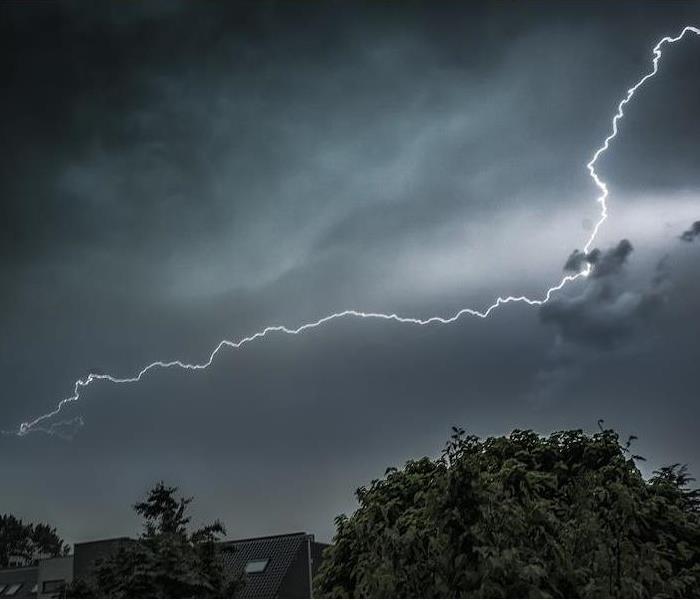 ??If your home has been damaged by a storm, call SERVPRO of Gordon, Murray, & South Whitfield Counties to help you recover faster.
??If your home has been damaged by a storm, call SERVPRO of Gordon, Murray, & South Whitfield Counties to help you recover faster.
The weather can be unpredictable. Severe storms that bring floods, heavy winds, hail and other hazards can suddenly sweep through and destroy lives. That’s why it’s advisable to take precautions around the house ahead of time to minimize damage.
Water damage and ruined infrastructure are the most costly consequences of a strong storm. And it can be costly—the national average cost of repairing your home after a storm is around $9,800. Preparing your Conyers home before storm season could save you money in the long run.
Start with these precautions you can take around your home to secure it before a storm:
Keep valuables safe. Flood water is notorious for ruining valuables within the home. Items such as family photos, clothing, heirlooms and other valuables can be protected from water damage by storing them in a watertight container. Keep them up high, preferably on a shelf or in your attic, where floodwater can not reach them.
Secure your roof. Your roof protects the interior of your home by keeping water out. When preparing for a storm, it is critical to reinforce your roof. Keep it well-maintained by nailing down or replacing any loose shingles. Once a storm has passed, have the roof inspected to ensure it’s still in good, working condition.
Clean your gutters and downspouts. July is usually the wettest month in Conyers, but storms can arrive at any time, bringing heavy rain that will rush through your gutters. When functioning optimally, the gutters and downspouts keep rainwater from running down the sides of your house and causing structural damage. Be sure to clear them of any leaves, twigs and any other debris to keep the water flowing.
Do some yard work. Cleaning up around the lawn can keep trees and debris from falling on your house during high winds. Trim any large branches that reach for your roof or are close to your house since they can break off and damage anything in their path. Clear dead plants, branches or shrubs to keep strong winds from blowing them against your windows or walls.
You can’t completely avoid storms, but you can do everything you can to protect yourself and your house. Regular weather maintenance and awareness is an effective strategy to safeguard your belongings and property from the consequences of severe storms.
If your home has been affected by water or infrastructure damage as a result of a major storm, we specialize in home restoration. Contact us right away, and we can restore your home to its preloss condition.
Storm Preparation Can Save Your Life
6/8/2022 (Permalink)
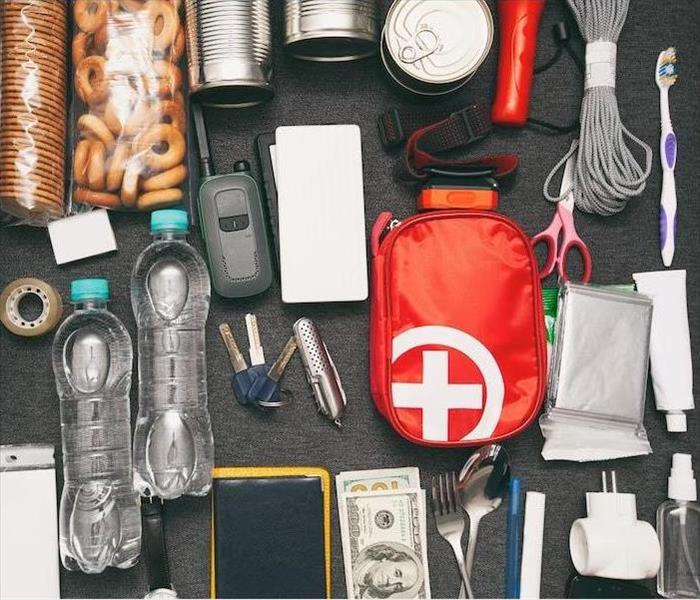 SERVPRO of Gordon, Murray, & South Whitfield Counties is ready 24/7 to help you recover from storm damage.
SERVPRO of Gordon, Murray, & South Whitfield Counties is ready 24/7 to help you recover from storm damage.
When a severe storm warning is issued, you race to prepare, unsure of what to do first to keep you and your family safe. Preparing for storms ahead of time can keep you from having to rush to make a plan.
But with that in mind, 42% of Americans say they do not have an evacuation plan in place. A lack of preparation for an impending storm puts you at risk of the storm’s fatal effects.
Here are a few steps you should take ahead of time to prepare:
Develop a safety plan. The first step in storm preparation is to create a safety plan. Make a household meeting place and, in the event of an evacuation, know where you need to go. Make sure that everyone in your household is aware of any impending weather events and what they can do to stay safe.
Pack an emergency kit. Having an emergency kit on hand ensures that all of the essential items you may need in the event of an emergency or evacuation are all in one place. Items such as emergency food and water, medical supplies, flashlights, and a first-aid kit should be included. Keep your kit in a location where everyone in the house can access it when needed.
Prepare valuable possessions. Flood water can enter your home during severe storms, and if your belongings aren’t in a safe area, they might be ruined by water damage. Passports, birth certificates, family photos and any other items that are too important to lose should be stored in a plastic bag or a waterproof container.
Stay informed. Keep an eye out for local weather alerts to get ahead of any approaching storms. You can stay up to date on current weather events by listening to local radio and television stations. Make sure you understand the difference between a storm warning and a storm watch, as they require distinct preparation measures.
Find a safe place to stay. If you need to shelter in place, stay in your basement or an interior room with no windows. If you feel you need to find a safer place to shelter, you can search for a local mass care shelter to evacuate to. Wherever you find yourself during a storm, be sure to always bring your emergency kit.
When severe storms damage your property, quick action can prevent further damage. SERVPRO is available 24/7 to repair storm damage of any size ASAP
Do You Have a Plan for Staff Safety in Severe Weather?
4/29/2022 (Permalink)
 Do you have a Plan for Severe Weather? Reach out to SERVPRO of Gordon, Murray, & S. Whitfield counties.
Do you have a Plan for Severe Weather? Reach out to SERVPRO of Gordon, Murray, & S. Whitfield counties.
Severe weather can be an extremely dangerous thing. Not only is it often unpredictable, but it is also quick-moving—meaning waiting to prepare when it becomes imminent can put you in harm’s way.
If you are a business owner, preparing in advance is even more important, as it will help you keep both yourself and your staff safer in the event of weather concerns.
If you have not yet put together a plan for severe weather, now would be the time to do so. Not only is it a requirement from OSHA that you have an emergency action plan in place, but it is also a smart way to keep everyone calm and comfortable even when the weather goes south. There are a lot of key elements in emergency planning, but below, we will focus specifically on some things to consider to keep your staff safe.
How to Keep Your Staff Safe During Severe Weather
**Make planning a collaborative process.** Having an emergency action plan is great, but it does not do much good for your organization if no one is aware of what the plan is. Make sure you include your staff in the planning process and keep them aware of what protocols to follow should severe weather become imminent.
**Make sure everyone’s needs are accounted for.** It is a good idea to pack a general emergency kit for your workplace to cover things like flashlights, first-aid supplies and general items to keep everyone comfortable in the event of a power outage. However, you should also encourage staff to have their own personal emergency kits that meet their needs—that way, if there is an emergency scenario, they will have access to necessities such as medication and personal items.
**Make it clear where everyone should go.** In the event of a severe weather event, you and your staff will need to seek shelter on-site until the threat passes. Be sure you have a safe area clearly identified so staff know exactly where to go. This area should not have any windows or external-facing walls, and ideally will be at or below the building’s ground floor.
*If your building has damage due to severe weather, we are the team to call! Contact us today to learn more about our storm restoration practices.*
Potential Spring Weather Hazards Across The Country and Close to Home
4/4/2022 (Permalink)
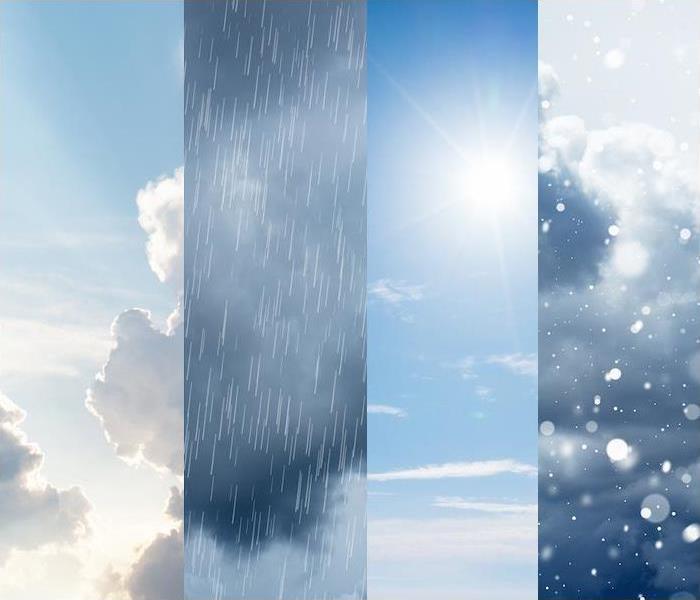 Extreme temperature changes can lead to the possibility of severe weather. SERVPRO of Gordon, Murray, & S. Whitfield is a click away.
Extreme temperature changes can lead to the possibility of severe weather. SERVPRO of Gordon, Murray, & S. Whitfield is a click away.
The United States is the third largest nation in the world, coming in behind Russia and Canada based on land mass.
When you have such a large geographical area encompassed in one country, “spring weather” season can have a much different meaning depending on where you are. There are all types of different weather events, which means there will also be different weather threats.
With spring right around the corner, read on for a look at what different parts of the country can expect, weather-wise.
First, let’s take a look at the Pacific Northwest region. The residents here experience heavy rainfalls during the spring months, causing flooding and water damage. There are areas with high elevations that may be dealing with a different type of wet weather—remnants of snow or ice melting, which cause problems of their own.
Now looking at the Upper Midwest and Northeast regions, these regions basically don’t know the difference between winter and spring! This region experiences winter weather to the fullest, dealing with snowstorms and blizzards all the way until early summer at times.
Then you have people living on the West Coast who don’t even know what winter weather is, as it’s almost non-existent in this area. Rather than blizzards or snow, they are dealing with excessive heat waves. These heat waves can endanger the lives of those living in the area, and they also contribute to wildfire conditions.
When you get to the middle part of the United States, you will notice that from Iowa to Texas they are dealing with dry, windy weather! Things like wildfires, windstorms and derechos are just a few of the weather hazards this area faces during spring. Not to mention an area that is named “Tornado Alley” is in this region as well.
Then you have the Southeast region, where we are located. We see spring as a wonderful time of the year; however, we do experience our fair share of weather hazards. Intense thunderstorms and even tornadoes are common this time of year. And states that border the ocean also have to look out for rip currents and early-season hurricanes.
So, what’s the point here? No matter what “spring weather” looks like in your neck of the woods, there are always weather hazards! That’s why despite of where you live, you will need to be prepared for any kind of weather event.
If extreme weather leaves you with damage from water, fire or other elements, help is a click away. Contact SERVPRO for fast, expert recovery.
Tornadoes 101
3/31/2022 (Permalink)
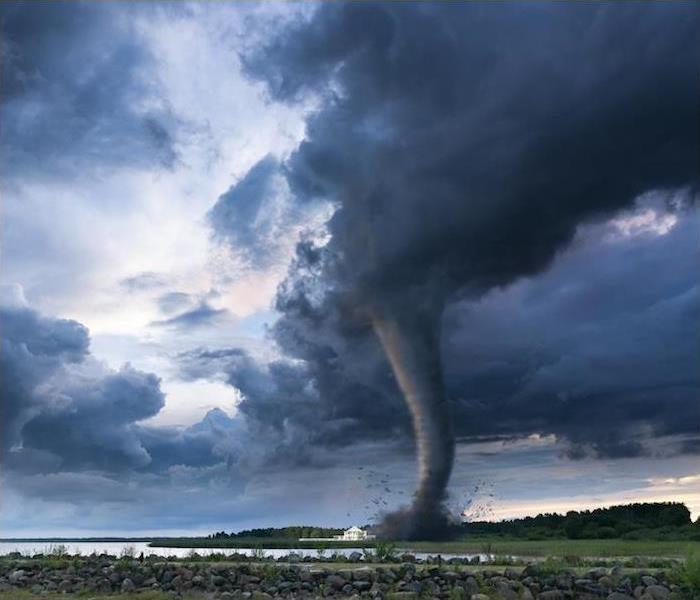 Spring storms can cause major damage to your property. If you experience any damage reach out to SERVPRO of Gordon, Murray, & S. Whitfield.
Spring storms can cause major damage to your property. If you experience any damage reach out to SERVPRO of Gordon, Murray, & S. Whitfield.
Georgia is prone to severe weather of all types but is particularly prone to thunderstorms and tornadoes. All of Georgia is prone to tornadoes throughout the whole year, but they are most likely to occur from March through May and peaking in April.
When there is severe weather, be sure to keep a close eye on how the weather changes and know how to identify tornadoes. Tornadoes are often accompanied by thunderstorms and can develop quickly, so it’s important to have dependable ways to get updates about storms by turning on your radio or TV, or by having notifications on your phone for weather alerts.
A tornado watch means that there hasn’t been a tornado sighting yet, but the weather is favorable for them to happen.
Once a tornado watch is issued, it’s important to stay notified through the tornado warning system in your area, stay tuned to local radio stations or an NOAA radio or have notifications on your mobile device for weather updates.
Most tornado-prone areas have an outdoor siren system. Know how to distinguish between the siren’s warnings for a tornado watch and a tornado warning.
A tornado warning is sent out as soon as a tornado has been spotted or shown on the weather radar. You should seek shelter as soon as a tornado is on the way.
Some tornadoes come quickly and without warning, so it is important to know what to look for. Signs that a tornado may be approaching include:
- A rotating funnel-shaped cloud
- Dark or green-colored sky
- Large, dark, low-lying cloud
- Hail
- Loud roar that can be compared to a train
If a tornado is heading your direction, it’s important to take shelter immediately in the lowest indoor area of whatever building you are in, away from windows. The best places to go are basements and cellars, but hallways or other windowless, centrally located areas are good, too.
If you are outdoors, find a place to take shelter, but if that is not possible, find a ditch and lay face down, covering the back of your head and neck with your hands.
Tornadoes and other severe storms can cause serious damage to your property. If your property is damaged by a storm in any way, SERVPRO of Gordon, Murray, & S. Whitfield has you covered. We are available 24 hours a day and seven days a week so we can begin the restoration process immediately.
What Is Your Business’ Storm Readiness Plan?
3/31/2022 (Permalink)
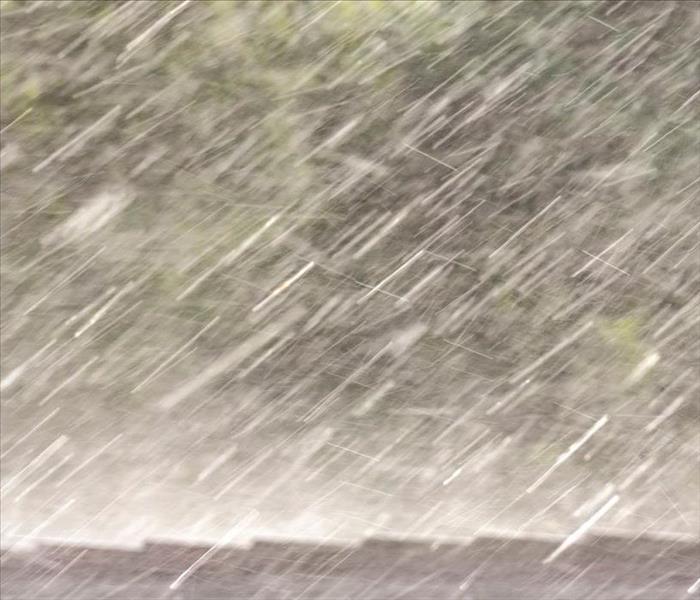 If you need help getting your business prepared for a storm, call SERVPRO of Gordon, Murray, & S. Whitfield counties.
If you need help getting your business prepared for a storm, call SERVPRO of Gordon, Murray, & S. Whitfield counties.
A severe storm is an unpredictable thing—with atmospheric uncertainty and ever-changing conditions, the timeline and severity of a storm can often be in question until the moment it moves into an area.
However, this uncertainty is not an excuse to not be prepared. In fact, it is all the more reason for business owners to put a plan into place. Not only does OSHA require all employers to draft a written emergency action plan to comply with their standards, but it is also a good idea from a practicality standpoint. Below, we will take a look at some key elements of your storm readiness plan to include so you can keep yourself and your employees as safe as possible should the weather turn dangerous.
What Do I Do for My Business’ Storm Readiness Plan?
**Create an emergency kit in case weather strikes on the job.** Unfortunately, storms never adhere to a convenient schedule, meaning the odds are high that one may strike while everyone is actively in the office. If this is the case, keeping everyone safe and comfortable is top priority while you wait for the storm to pass. An office emergency kit, which should include food, water, flashlights and a weather radio at minimum, will keep everyone comfortable should the power go out and require you to stay put until the threat is over.
**Communicate with your employees.** Trying to communicate instructions and convey new information in a stressful scenario is never ideal, so take this opportunity to communicate with your employees in advance so they are aware of the severe weather protocol. Let them know what your plan is, where they should seek shelter in bad weather and what to expect in an emergency scenario.
**Protect your business’ data.** Because most things are digital now, rain can be quite dangerous to business data. Be sure that your data is backed up, either on an external hard drive or in the cloud, so it can be retrieved even if key computers get water damage due to severe weather.
*If your business sustains damage due to a storm, we are the team to call. Get in touch with us today to learn more about how we can help.*
Areas we Inspect After Storm Damage
3/23/2022 (Permalink)
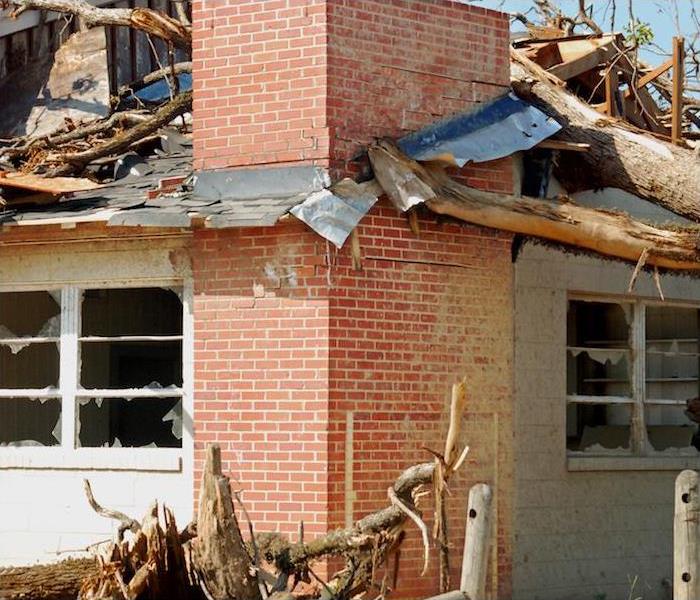 SERVPRO of Gordon, Murray, & S. Whitfield will help you with the whole restoration process after a storm. Call us today.
SERVPRO of Gordon, Murray, & S. Whitfield will help you with the whole restoration process after a storm. Call us today.
You never know when you might suffer property damage due to bad rain, storm damage, wind or debris. In the wake of severe weather, you’ll want to contact SERVPRO to inspect, document and restore any damages to your business for you.
There is a lot you can do to mitigate storm damage, but it’s never completely preventable. Storms can be extremely costly to businesses.
In fact, experts predict that storm and flood damage could cost businesses over $13 billion in 2022.
It’s not always easy for the untrained eye to spot damage after a storm, and damage that goes unnoticed can grow and become even more costly and destructive. When you call SERVPRO to inspect the damage, here are just a few of the main areas we would look for when inspecting your property:
The Roof
Roof damage is one of the most often-occurring kinds of storm-related property damage. We will inspect the roof for loose, curled, missing or cracked shingles.
Additionally, dark patches on asphalt shingles may indicate water damage. Dents or weakened areas on the shingles are indicators of hail storm damage.
We will check for water damage indoors that has sneaked through a damaged roof. Water stains or leaks running down the wall, through a skylight or pooling in the center of the ceiling are further indications that the roof has a leak.
However, not all indications of water damage are obvious. The wisest course of action is to hire an expert to evaluate your house and search for indicators of a leaking roof.
The Exterior
Following a severe storm, you’re likely to find debris scattered around the exterior of your property. These pieces of debris may strike your property, cars or other structures, such as barns or machinery.
We will inspect the whole exterior of your property for loose or broken siding, doors, windows and gutters, among other things. Oftentimes, the exterior can be a significant source of unwanted water leakage that can cause interior water damage and flooding during a storm.
Dents or bends in gutters are often the result of hail, wind and/or debris damage. It is critical to employ an expert to evaluate, record and repair any possible damages precisely and safely.
Windows and Doors
Windows may potentially sustain damage during a severe storm, especially one with heavy winds. Our technicians will inspect the glass for broken panes, shattered glass, chips, scratches and fractures. Additionally, we will search for indicators of damaged seals that allow water to enter through windows and doors.
SERVPRO of Gordon, Murray, & S. Whitfield will help you with the whole restoration process after a disaster, from damage assessment through restoration and rebuilding. Do not hesitate to contact our professionals to get your storm damage emergency repaired immediately and properly.
Can Lightning Cause Serious Property Damage
3/14/2022 (Permalink)
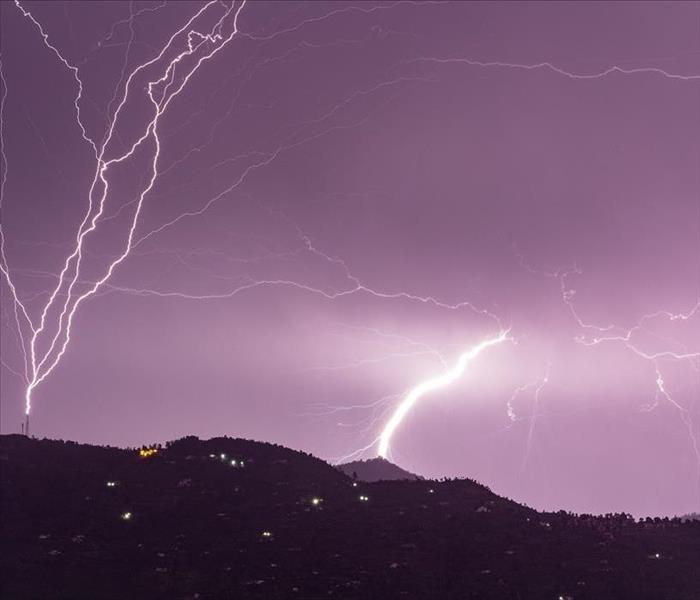 Lightning can cause serious property damage. If you need help repairing your home after lightning damage, contact SERVPRO of GMSW today.
Lightning can cause serious property damage. If you need help repairing your home after lightning damage, contact SERVPRO of GMSW today.
Though most rain fronts that pass through our area are no major event, severe weather is something that is entirely different. Severe weather can strike nearly any time of year if conditions are right, and with it, bring heavy rains, high winds, lightning strikes, hail and more—all of which can be rather dangerous.
Many of us are cognizant of the injuries and fatalities that lightning strikes in particular can cause. Around the world, they are responsible for 2,000 deaths each year and many more injuries. However, did you know that lightning can cause serious property damage, too? Below, we will be taking a look at why lightning strikes where it does and the types of damage to be aware of.
Why Does Lightning Strike Where it Does?
The majority of lightning strikes that occur during any given thunderstorm will be from one cloud to another as the electrical charge is transferred from area to area in a storm. However, with all this electricity in the air, lightning can also begin to target the ground, as objects such as buildings, trees and bushes send up sparks to meet it. While it is true that taller objects are more likely to be struck by lightning, it is not a guarantee—lightning will strike anywhere there is a charge, whether it be the ground, a tree or a home.
How Does Lightning Cause Damage?
When lightning strikes a building, it can cause serious property damage as a result. The main ways this can happen are:
* Damage due to fire where lightning strikes. When lightning strikes, it is incredibly hot—and therefore, this heat will be transferred to the impacted target. In many cases, this will cause immediate combustion at the site of the strike.
* Damage due to electrical fires. In addition to the threat that lightning can cause an initial fire where it strikes, it can also cause damage due to electrical fires. Because lightning carries an electric charge, it will travel through a building’s wires once it makes contact—this can cause damage to those wires and lead to an electrical fire, either immediately or later on.
* Water damage due to impact. Even if it does not start a fire, lightning will leave a hole where it strikes a home, which can lead to water damage if it is raining.
*If you have damage to your home, due to lightning or other storm-related causes, we are the team to call. We are here 24/7 to help—get in touch today.*
How Can High Winds Cause Damage During a Storm
3/8/2022 (Permalink)
 If your home has been damaged due to high winds, call SERVPRO of Gordon, Murry, & S. Whitfield 24 hours a day. ??
If your home has been damaged due to high winds, call SERVPRO of Gordon, Murry, & S. Whitfield 24 hours a day. ??
When it comes to severe weather, there are a lot of ways it can cause harm to an impacted area. More than 75% of deaths pertaining to natural hazards are a result of severe weather, and the property damages caused by storms can be far-reaching and severe. When most people consider severe weather hazards, heavy rains and lightning strikes are probably the first things that come to mind—but unfortunately, straight-line winds can also be significantly damaging to property and people.
Damaging straight-line winds are anything over 50–60 miles per hour, but gusts can reach up to 100 miles per hour if conditions are favorable. When thunderstorms are over an area, they will often cause downdrafts of wind that impact the ground below in several unfavorable ways, which we will look at below.
How Do High Winds Lead to Storm Damage?
**They can rip limbs from trees.** While trees grow to have a certain amount of flex to them in order to withstand the threat of high winds, occasionally, branches will still be ripped from the tree. This is especially true of branches that grow at an odd angle or are less than healthy, which is why trimming trees regularly is so important. When limbs are ripped from trees, they can become high-speed projectiles, crashing into any object or home that ends up in their path.
**They can topple mobile homes.** Because straight-line winds can reach up to 100 miles per hour, they can easily generate an extremely strong force—and in many cases, this can be enough to topple mobile homes or trailers. Even anchored mobile homes can be at risk if winds are strong enough, which puts the people who seek shelter in these homes at serious risk.
**They can make homes more susceptible to water damage.** High winds and water damage often go hand in hand, because winds can cause damage to homes that make them more susceptible to water damage. Projectiles carried on the wind can shatter windows, which will then let in rain. Additionally, high winds can damage roofing shingles, flashing and other exterior elements of the home designed to keep moisture out, resulting in hidden leaks that can be costly.
*If you have storm damage to your home, you can count on our team to help. Get in touch today to learn more about our restoration processes—we’re here 24/7 to help.*
The Dangers That Occur When Severe Weather Strikes
3/2/2022 (Permalink)
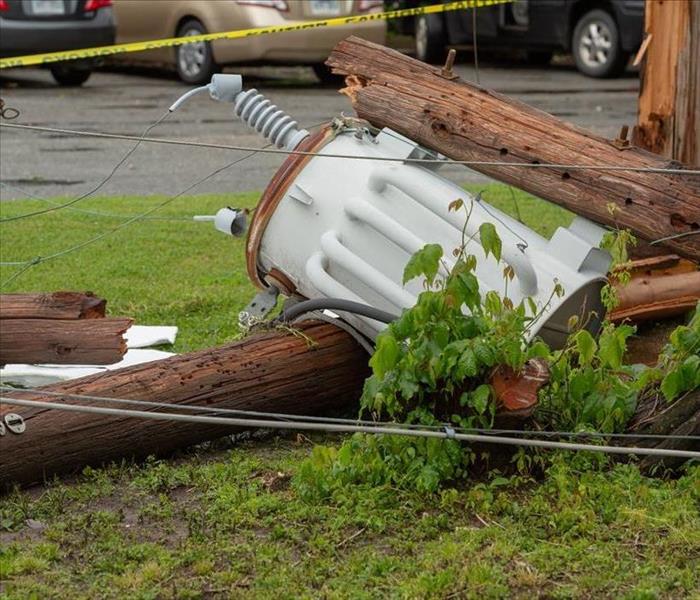 If your home is damaged from flash floods, lightning, or hail call SERVPRO of Gordon, Murray, & S. Whitfield 24 hours a day!
If your home is damaged from flash floods, lightning, or hail call SERVPRO of Gordon, Murray, & S. Whitfield 24 hours a day!
More than simply being an inconvenience, severe weather can cause serious damage in a variety of ways. In addition to being dangerous enough to cause personal injury to anyone who has not sought out adequate shelter, severe weather can also cause property damage to any homes or businesses in the line of the storm.
While severe weather can often move through an area without causing much damage, any time it is a possibility, it is wise to be vigilant so you know when to seek safe shelter to protect your family. Below, we will be taking a look at the types of hazards that happen during severe weather so you can be better prepared for their occurrence.
The Types of Hazards That Occur During Severe Weather
**Flash flooding threats.** Flash flooding is a serious problem, in part because it is quite unpredictable—hence the term “flash.” Flash flooding is more common in low-lying areas, but it can happen anywhere that receives a heavy amount of rainfall in a short period of time. Rapidly rising creeks and ponds are often sources of flash flooding, but even overwhelmed storm drains can become backed-up and impact an area.
**Fire hazards from lightning strikes.** Lightning strikes can occur any time there is a thunderstorm, and they are responsible for around 2,000 deaths per year throughout the world. In addition to being dangerous for anyone caught outside, lightning strikes can also introduce serious fire risks when they strike homes. Lightning can start a fire when it hits a home, due to the intense amount of heat it transfers, but it can also cause electrical fires as it travels through (and damages) a home’s wires on its way to seeking grounding.
**Damage due to high winds and hail.** Severe weather is often accompanied by high, straight-line winds up to 100 miles per hour—which as you can imagine, can cause serious damage. High winds can break off tree branches and turn them into projectiles, which can shatter windows, damage roofs and make homes susceptible to water damage as a result of being vulnerable to heavy rains.
*If severe weather strikes your home, you can depend on us to help. We have a team of storm restoration experts on hand 24/7—contact us today to learn more.*
The Most Common Roof Problems You’re Likely to Encounter
2/2/2022 (Permalink)
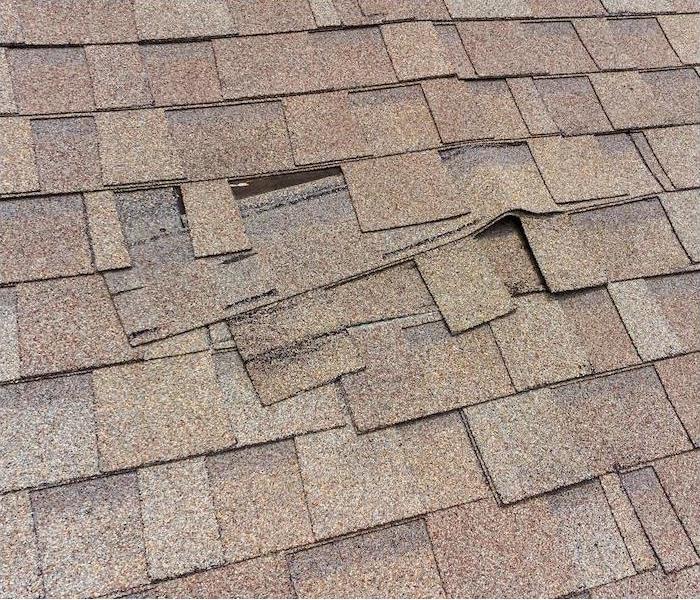 Roof care is home care. If you find any signs of damage to your property, call SERVPRO of Gordon, Murray, & South Whitfield.
Roof care is home care. If you find any signs of damage to your property, call SERVPRO of Gordon, Murray, & South Whitfield.
One of the sneakiest water damage sources in your home is actually on your home. Your roof regularly takes a beating from weather, sun, wind, rain and more, and it does a great job overall. If we were talking percentages, we’d be looking at Hank-Aaron-meets-Ted-Williams-type numbers.
But roofs are also one of the last places we tend to check for leaks, and thusly, one of the last places we catch leaks before they become a problem.
Make this your year to change all that. Keeping an eye on these problem areas can keep water from sneaking into your home through cracks and gaps in the roof.
Storm damage. Wind, hail and other environmental factors can damage your roof during a storm. No matter the season, your roof takes a pounding from storms, and you should always inspect your roof visually after a major storm, at the very least. If you suspect anything negative may have occurred, play it safe and let a pro examine it.
Falling branches and tree damage. Overhanging branches can crack and fall, but they can also rub away the top layer of your shingles over time as they sway with the wind. Trimming trees and being mindful of their proximity to your roof can help you avoid bad shingles and subsequent leaks.
Flashing. Your roof likely already has holes in it, but they’re the kind you have to have. Chimneys, vent pipes, skylights and even HVAC systems all come through your roof for ventilation. If the flashing is poorly installed, or if it simply wears down over time, it can cause seams in your roof and pull shingles and tiles off their proper alignment. Flashing may also need to be resealed from time to time.
Mold. Those dark streaks and patches on your roof are easy to ignore, but they’re really patches of mold—and that’s never good. There are many reasons to get rid of mold whenever and wherever you see it, but in the case of your roof, that mold can eventually eat away at your roofing material, which can let water in.
Gutters. While technically roof-adjacent, this one certainly needs attention as well. Keeping your gutters free of debris and buildup can stop water from damming up and flowing into your house by getting under your shingles.
Time. The truth is, your roof has a life expectancy, and even within that window it’s likely to develop needs that you can’t see from the ground or as an amateur. An annual roof checkup is recommended in order to keep your roof performing at its peak. A professional can identify problems that are, and some that have not yet come to pass.
Roof care is home care, and leak prevention is the name of the game. If water damage becomes an unexpected part of your home ownership experience, contact SERVPRO to get things cleaned up and restored.
Let Us Help You Rebuild After a Storm
1/17/2022 (Permalink)
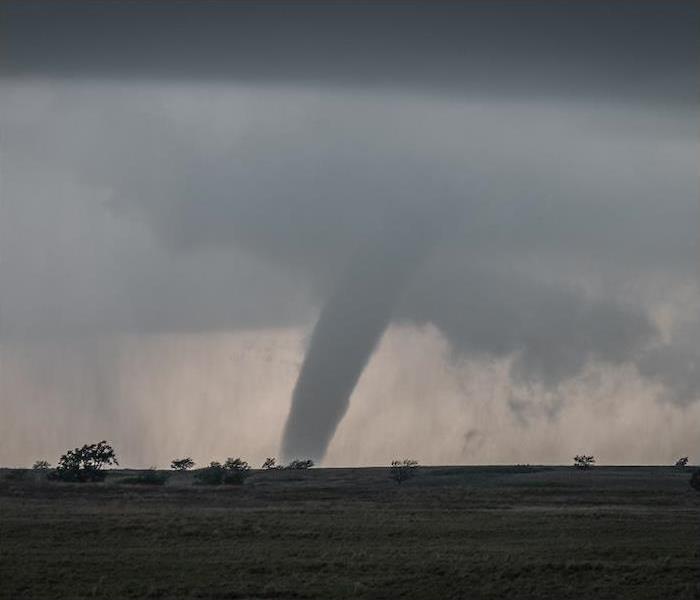 When storms strike your home or business, trust us to make things right again. SERVPRO of Gordon, Murray, & South Whitfield Counties is here to help.
When storms strike your home or business, trust us to make things right again. SERVPRO of Gordon, Murray, & South Whitfield Counties is here to help.
You know what SERVPRO does by now. You see the green truck with the orange logo, and you feel pretty sure somebody’s about to get some water damage cleaned up.
They had a pipe burst or a sewage backup, and a SERVPRO team is headed to get them back in the dry. Or maybe they had a fire in the kitchen, and the green team is on their way to clean up and remove the smoke damage and smell.
These things may all be true, and kudos to you for your acumen. But something you may not know about SERVPRO of Gordon, Murray, & South Whitfield Counties is that we can provide full-blown reconstruction when your home or business is damaged, whether you’ve had something as minor as drywall or carpet damaged by intruding water or you’ve experienced an extreme disaster. When disaster strikes, we’ve got the teams, the tools and the expertise to repair or fully rebuild.
Not only can we rebuild and reconstruct to get your home back to its preloss condition, but we can simplify your life by simplifying your post-damage process. You can trust SERVPRO of Gordon, Murray, & South Whitfield Counties for initial damage assessment, for the emergent needs for repair and mitigation, and for putting your home back together the way you know and love it.
With a streamlined process handled all by one excellent team, you can have peace of mind knowing everything is taken care of, and nothing is missed or miscommunicated.
SERVPRO of Gordon, Murray, & South Whitfield Counties is licensed for residential contractor services, so you know you can trust our workmanship as well.
We can help with every area of your repair, rebuild and reconstruction process, including board up, dry cleaning, electrical, and HVAC services, plumbing and much, much more. We can even help with temporary fencing and warehouse space.
There’s so much more to SERVPRO of Gordon, Murray, & South Whitfield Counties than what you may think when you see the green truck. The bottom line is that if you’ve got a repair or restoration need of any kind at home, we can help you get it taken care of. Call us first—it’s likely we’ll be the only call you have to make.
When storms strike your home or business, trust us to make things right again. From initial evaluation to the finishing touches, SERVPRO is here to make your life easier after a storm.
What to Do When You Need a Storm Shelter?
1/14/2022 (Permalink)
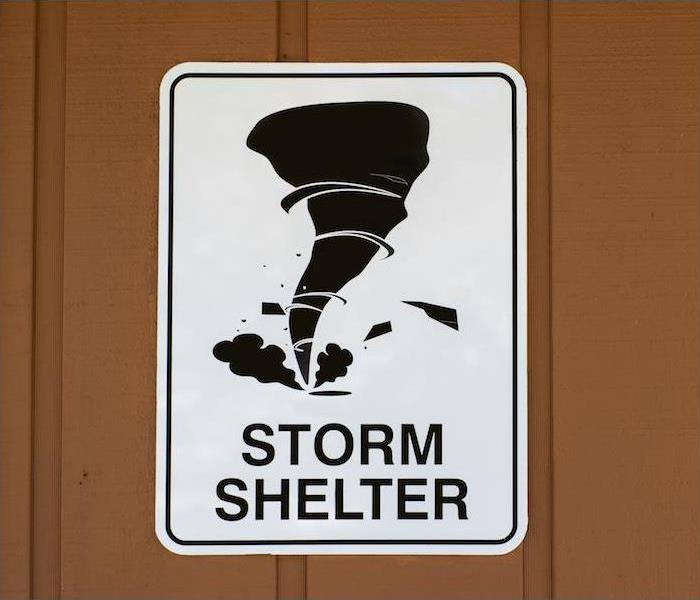 If a storm should strike and do damage to your home, SERVPRO of Gordon, Murray & South Whitfield Counties is here to help.
If a storm should strike and do damage to your home, SERVPRO of Gordon, Murray & South Whitfield Counties is here to help.
Some storms are worse than others. You can’t always see that kind of destruction coming, and the unfortunate truth is that some day a weather event may take place that may cause you to suddenly be in a place where staying or returning to your home isn’t a safe option.
In the following blog we’ll go through what you need to know—how to find a reputable shelter nearby, how to know if you’re eligible, what to bring and what to expect.
Find a reputable shelter, such as a Red Cross shelter. Red Cross shelters are free and open to absolutely anyone in need due to a disaster or emergency. Service animals (not pets) are also welcome, and the shelter can assist with food or supplies.
The Red Cross provides a searchable map on their website, which can help you find the nearest shelter. Additional shelters open during a crisis, so it always pays to check.
If you have special needs or have requests regarding food, supplies or religious requirements, the Red Cross volunteers will do what they can to accommodate you and make you comfortable.
You can bring certain items with you, such as bedding, clothing and medication. If you have children who have a beloved special stuffed animal or blanket, they are welcome to bring it for comfort.
You can also bring your own emergency kit. Of course, if you don’t have time to pack these things before you evacuate, or the emergency happens while you are away from your home, the shelter will do everything possible to get you what you need.
Don’t bring weapons, illegal drugs or alcohol to the shelter; they will not be allowed inside.
Your Red Cross shelter will provide a safe refuge from the storm or disaster event, food and water, first-aid and basic health services, as well as a laundry list of other helpful things like childcare, laundry and access to case workers who can assist you with recovery.
Red Cross shelters remain open until all guests have procured a safe place to stay, and they will help you as needed when you return home, or if you need assistance finding a temporary place to stay while your home is repaired.
There may be other shelters available in the event of an emergency as well, but you always know the Red Cross is a trustworthy sign of help in a crisis.
If a storm should strike and do damage to your home, SERVPRO of Gordon, Murray, & South Whitfield Counties is here to help. Contact us anytime to make a connection or find out how we can help restore or even rebuild your home after a weather emergency.
Is Your Household Prepared for Severe Weather?
12/30/2021 (Permalink)
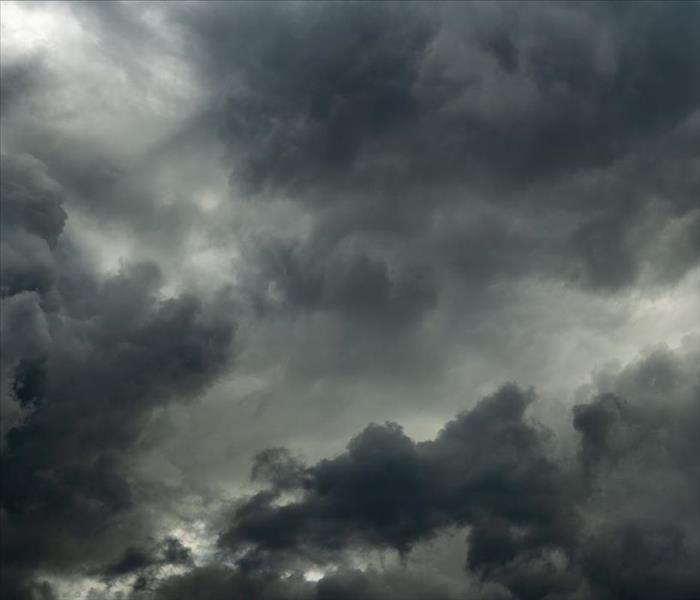 If you have damage to your household due to severe weather, contact SERVPRO of Gordon, Murray & South Whitfield Counties today.
If you have damage to your household due to severe weather, contact SERVPRO of Gordon, Murray & South Whitfield Counties today.
While severe weather is an inevitable occurrence, it is something that many people find themselves to be unprepared for when the moment strikes. Because many storms come and go without ever causing damage, it is all too easy to assume that there is no real danger present—until there is.
Preparing for severe weather may not be the most glamorous of tasks, but it is something that will help keep you and your family safer during severe weather—and it can even reduce the likelihood of damage occurring to your home, too. If you are unsure whether your family is prepared as possible for severe weather, read on to learn some things to take note of.
A Checklist to Make Sure Your House Is Prepared for Severe Weather
Do I have an emergency kit built? You should have an emergency kit located in an easily accessible place that contains enough food and water for every member of your household for at least a few days, as well as first-aid supplies, flashlights and batteries.
Do I have a designated safe storm area? Having a place to go to in case of severe weather is a must, so it is wise to designate an area of your house as your family’s safe place. Ideally, this is a basement, but it can also be a bathroom, closet or any other area in the home that does not have any windows.
Do I know where my local shelters are? You will typically be advised by emergency officials to stay put in the event of severe weather, but if there is an evacuation order, it is important to know where to go. Make sure you know where the shelters in your area are located and which ones accept families with pets, if applicable.
Do I have an emergency radio? During severe weather, cell phones can be an unreliable source of information between power outages and cell phone reception issues. An emergency weather radio, either a hand crank or battery-powered model, is the most reliable way to get pertinent information from local weather officials.
If you have damage to your household due to severe weather, do not hesitate to give us a call. We are here 24/7 to provide a rapid response— contact us today.
How to Choose a Designated Storm Shelter Area in Your Home
12/29/2021 (Permalink)
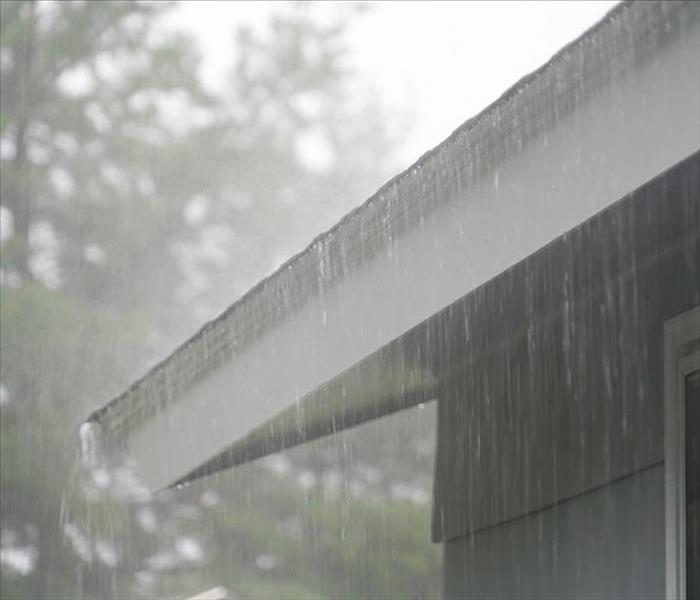 Contact SERVPRO of Gordon, Murray & South Whitfield Counties today to learn about how our storm restoration services can help you in the aftermath.
Contact SERVPRO of Gordon, Murray & South Whitfield Counties today to learn about how our storm restoration services can help you in the aftermath.
Severe weather is a frightening thing to think about, but unfortunately, it is something that one
must consider.
Severe weather can strike anywhere and be quite unexpected, and if you are caught off-guard by its arrival, it can be rather dangerous, too. Preparing and planning ahead is the best way to
minimize the impact that severe weather has on your household, so doing what you can to keep
yourself safe is a wise decision.
One of the first things to do as you increase your severe weather preparedness is to choose a designated area of your home where your family knows to go if there is severe weather in the
forecast. That way you will all immediately know where to head when there is the threat of severe weather and you can streamline the process of sheltering until the event passes.
Below, we will help you think through which areas of your home might be best for sheltering in place so you and your household can stay safe.
Deciding Which Area in Your Home to Use as a Storm Shelter
Use the lowest possible level of your home. Severe weather typically brings high winds with it, and can even lead to tornadoes. That is why it is recommended to choose a storm shelter on the lowest area of your home—if you have a basement or cellar, this is the most ideal, but if not, somewhere on the ground floor of the home is a good place to start.
Choose an area without windows, if possible. Windows can get blown out in storms, either due to high winds or airborne debris such as tree branches or potted plants. If you can, choose a shelter area that has no windows to minimize your risk of injury while sheltering.
Pick a spot in the middle of the house. A good rule of thumb is to put as many walls between yourself and the storm as possible. While this will vary quite a bit based on the layout of your home, try to pick a sheltering area that is toward the middle of your house so the walls can act as a sturdy buffer against the storm.
If you have storm damage to your home, we are the team to call. Contact us today to learn more
about how our storm restoration services can help you in the aftermath.
Do You Know Where Your Tornado-Safe Room Is?
9/21/2021 (Permalink)
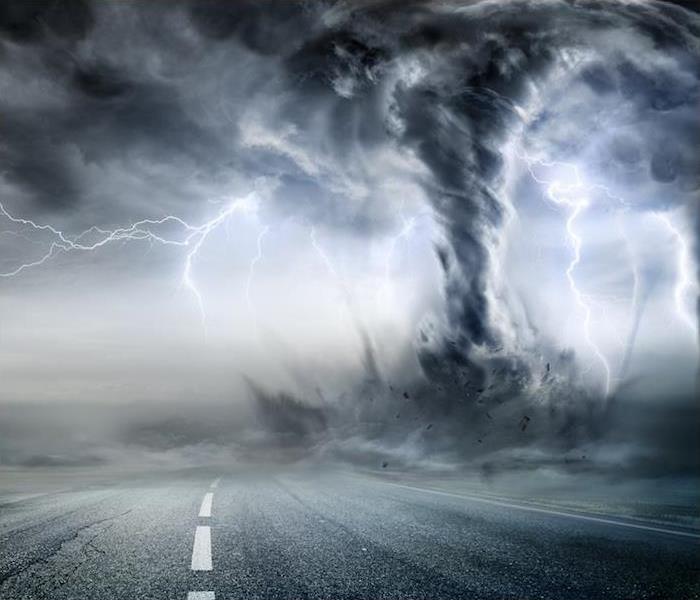 Storm season is on its way. SERVPRO of Gordon, Murray and South Whitfield Counties is available 24/7 in case a storm event hits your home.
Storm season is on its way. SERVPRO of Gordon, Murray and South Whitfield Counties is available 24/7 in case a storm event hits your home.
Here’s a simple question with an answer that can help you keep your family safe: Do you know where the safest room in your house is if a tornado strikes?
That may sound like an odd thing to ask, but given that Georgia has, on average, about 30 tornadoes every year, it’s worth considering. These storms are dangerous and can damage property, cause injuries and even death. So it’s a good idea to know where to go in the event you need protection from a tornado.
There are a lot of options in today’s market. Some homeowners even opt to have a safe room added to or created inside their existing home. But many homeowners don’t have the ability to take this step. In these cases, it’s smart to know where to go in your existing home.
Here’s what the experts recommend to look for in a tornado-safe room:
Find a windowless space in the interior of your home. Your safe room is best if it doesn’t have exterior walls or windows. Think about bathrooms or closets.
Choose a room on the lowest floor of your home. The best spaces to take shelter during a tornado are on the lower floors of your home. Choose spaces on the lowest floor or the basement.
If your home isn’t safe, know an alternative location. Experts agree that in mobile or modular homes no room is safe from a tornado threat so it’s a good idea to have an alternative place to go. Additionally, if you live in a high-rise building or an apartment, ask your building manager about laundry rooms, basements or other safe areas.
If a fire, flood or any other cause damage to your home, you can always count on us for restoration assistance. We are available 24⁄7 in the event of an emergency. Contact us at any time to learn more about our restoration services and how we can help you.
Preparing Your Business for a Storm
8/25/2021 (Permalink)
A Severe Weather Plan can help you prepare for an approaching hurricane or another severe weather event. Make sure everyone in your business, especially your leadership team, understands the Severe Weather Plan. Each year, review the plan and update it as necessary.
- Take the necessary precautions
- If a storm threatens, secure your building and move equipment/furniture to a secured area.
- Protect data with backup files
- If your business depends on data processing, consider an alternate site. You should also make provisions for alternate communications and power.
- Employee safety comes first. Prepare, distribute and follow your business hurricane plan for recovery.
- Consider providing shelter to employees and their families and helping with supplies after a storm.
- Establish a rendezvous point and time for employees in case communications are disrupted.
- Establish a call-down procedure for warning and post-storm communications.
- Provide photo IDs and a letter of authorization to enter the building.
- Check your hurricane evacuation level and FEMA flood maps to determine if your business location is vulnerable to storm surge or freshwater flooding.
- Have your building(s) inspected by a licensed professional to find out if your workplace is vulnerable to hurricane force winds and what is recommended to retrofit.
 If your home has been damaged by a storm, contact SERVPRO of Gordon, Murray, & South Whitfield Counties 24/7 to get the recovery process started.
If your home has been damaged by a storm, contact SERVPRO of Gordon, Murray, & South Whitfield Counties 24/7 to get the recovery process started.



 24/7 Emergency Service
24/7 Emergency Service















